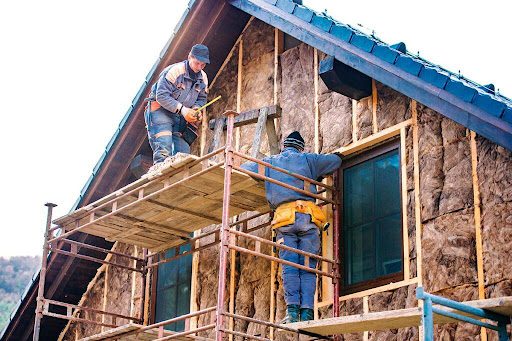Insulation in your home provides resistance to heat flow and lowers your heating and cooling costs. Properly insulating your home not only reduces heating and cooling costs but also improves comfort.
According to the North American Insulation Manufacturers Association (NAIMA), 90% of single-family homes in the U.S. are under-insulated, so chances are high that your house could use some work. Homes built prior to 1960 are particularly vulnerable.
Insulation is the best and first solution to a warm, healthy home environment for families of all types and installing home insulation is also one of the best things you can do to lower power bills to make your home more energy-efficient.
Why Insulate Your Home?
A well-insulated home will provide year-round comfort, and cost less to heat and cool your home. Insulation also helps regulate condensation and reduce noise levels. We can all agree that a well-insulated house is more comfortable and it can also be cheaper to heat, contain less mold and mildew, and be less conducive to allergy-aggravating dust mites.


Here are our 5 top reasons to insulate your home:
- Greater energy efficiency along with lower energy bills.
- The impact from windows is limited if the rest of the home isn’t air tight and well insulated.
- Energy efficiency is becoming increasingly important to homeowners and tenants.
- Insulating your home helps reduce outside noise and noise between rooms and other floors.
- Insulation can promote a healthier home especially if you have family members prone to asthma and other breathing difficulties.
How Insulation Affects Your Energy Bill
The EPA estimates that the average homeowner can save 15% on heating and cooling costs which equate to around 11% of total energy costs, just by adding insulation in crawl spaces, attics and basements. For most people, that is approximately $200 in savings per year.
In colder parts of the country, savings increase up to 20%. With these statistics, it is easy to understand the savings you would obtain over time once investing in the insulation of your home.
On average heat loss is lost through the following ways in your home:
- 33% of heat loss happens through the walls.
- 26% of heat loss is via the roof.
- 18% through gaps in and around windows.
- 12% via ventilation & draughts.
- 8% of heat loss is through the floor.
- 3% of heat loss is through gaps in or around the door.
How Insulation Works
To understand how insulation works it helps to understand heat flow, which involves three basic mechanisms – conduction, convection, and radiation.
Conduction
The way heat moves through materials, such as when a spoon placed in a hot cup of coffee conducts heat through its handle to your hand.
Convection
The way heat circulates through liquids and gases, and is why lighter, warmer air rises, and cooler, denser air sinks in your home.
Radiation
Radiant heat travels in a straight line and heats anything solid in its path that absorbs its energy.
Most common insulation materials work by slowing conductive heat flow and convective heat flow. Radiant barriers and reflective insulation systems work by reducing radiant heat gain.
To be effective, the reflective surface must be in contact with an air space.
Regardless of the mechanism, heat flows from warmer to cooler areas until there is no longer a temperature difference. In your home, this means that in winter, heat flows directly from all heated living spaces to adjacent unheated areas. Heat flow can also move indirectly through ceilings, walls, and floors.
Basically, wherever there is a difference in temperature. During the colder seasons, heat flows from outdoors into the interior of your home.
To maintain comfort, the heat that is lost during winter must be replaced by your heating system. During summer, the heat gained from the temperature must be removed by your cooling system.
By properly insulating your home, the transference of these temperatures will decrease creating a comfortable environment.
4 Types of Insulation for Your House
Fiberglass Insulation
This is the most common form of insulation. Fiberglass is available in either loose fill or batts. The best part of insulating your house this way is that this is more cost effective and also the easiest way to provide insulation for your home. Fiberglass insulation also prevents your house being damaged from any dampness and condensation. This material is non-flammable and further protecting your home.
Fiberglass insulation is done mainly between joists, beams, and studs.


It is important to note that fiberglass should be handled by a professional as the particles can affect your lungs and skin. It is best to remain away from your property during installation.
Spray Foam Insulation
Spray foam insulation is installed with aid of spray holders. Foam is ejected as spray from the containers in specific places of the house.
Spray foam insulation is best placed between new wall spaces, unfinished attics or existing walls. Although the foam is sprayed using spray holders, it can also be applied in large quantities, using a pressure spray.
Mineral Wool Insulation
Mineral wool insulation is also known as rock wool insulation. This is almost similar to fiberglass insulation and material. Mineral wool is easy to install and comes in loose fills, which can be poured directly from bags or be blown to a certain area. Mineral wool insulation material can tolerate higher temperatures. The house also remains soundproof when insulated mineral wool.
Cellulose Insulation
If you are looking for an organic way to insulate your home, cellulose insulation will be the closest option for you. Cellulose insulation is typically made from recycled paper, mainly newspapers and sometimes cardboard and other types of papers. This insulation material comes in loose fills.
Cellulose insulation materials have to be treated with chemicals to make them better in protecting the home from moisture, heat, and pests. However, it should be remembered that as this kind of insulation absorbs moisture and can get damaged with time. With this damage and with the 5 yearly recommended replacement, the overall installation costs for cellulose insulation for your home will be much higher as compared to the conventional fiberglass insulation option.
Is Upgrading Your Insulation Worth It?
For most homeowners, upgrading an under-insulated home is well worth the expense. It’s an improvement that will pay off in both reduced energy bills and improved home value. There is also the added benefit of reduced greenhouse gas emissions. Therefore we recommend to take the time to evaluate and develop a plan that’ll leave you with a properly sealed and insulated home.
References
- Energy Gov, Energy Saver Insulation, https://www.energy.gov/energysaver/articles/askenergysaver-insulation
- Insulation Institute, https://insulationinstitute.org/
- Ced Engineering, Heat Loss Calculations, https://www.cedengineering.com/userfiles/Heat%20Loss%20Calculations%20and%20Principles%20R1.pdf
- Home Stratosphere, Types of Insulation for Your House, https://www.homestratosphere.com



